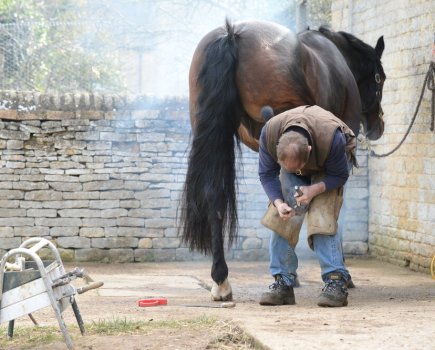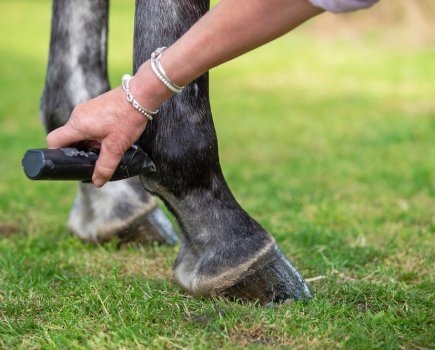Once your horse’s hooves start to crack, it can be tricky to get them back into good condition. Routine hoof trimming, especially if your horse is barefoot, and/or being shod at regular intervals is an essential part of taking care of a horse. It is vital for horse hoof care and will help to prevent hoof cracks occurring.
As a general rule, when you look at your horse’s feet there should be a nice constant angle — if a hoof splays out at the bottom, this will predispose them to cracking, explains farrier Dale Beecham. As with everything hoof-related, the best thing you can do to protect your horse’s feet and keep them in good condition is to have them shod regularly every six to eight weeks.
Crucially, you should also have a good dialogue going with your farrier. Your farrier is the expert. They know your horse’s feet and are in the best position to offer advice.
How to manage a cracked hoof
When it comes to managing a horse whose feet crack easily, there are several options:
1. Look at shoe position and bars
Your farrier can position any clips on the shoe away from the cracked area to avoid weakening it further, and bar shoes (shoes that have a closed heel rather than a traditional open one) can be used to help strengthen the hoof. Kevlar plates and acrylics can also be used.
2. Apply the right topical products
A hoof hardener or moisturiser can help to improve the condition of a horse’s hooves. As a rule, use a product that does the opposite to the weather. By this, we mean use a moisturiser when it’s very dry to prevent dried out hooves and a hoof hardener when it’s wet to prevent them becoming too soft.
3. Don’t wash hooves before a shoeing
Avoid washing your horse’s feet just before the farrier comes. Many owners think we want to see a clean, freshly washed foot, but if you imagine the hoof as a sponge, what will happen when you drench it with a hose? It will absorb the water and swell, of course. Farriers will do their best to get the foot level, but if we shoe a wet foot, the shape will alter as it dries, and this can lead to splits forming.
4. Add nutritional support
A balancer or hoof supplement can help to boost hoof health, but bear in mind that these take four or five months to take effect, so you have to give them time to make a difference. There are no quick fixes where hooves are concerned.
5. Identify potential deficiencies in your horse’s diet
You can have your hay and pasture analysed to see if your horse is missing any nutrients that are vital to hoof health. A balanced diet is essential to healthy hooves, as well as good all-round health of your horse.
Assess the situation
As mentioned, flared feet are the most common cause of vertical cracks, which can travel up the foot and lead to lameness. If the cracks run horizontally, this generally causes less of a problem. Horizontal cracks are normally the result of a previous abscess or damage to the coronet band, and will simply grow out to the point where your farrier can pare them off.
Whatever the cause and effect of cracked hooves, the message is simple: keep to a regular shoeing/ trimming routine and ask your farrier for advice if you’re at all worried.
Meet the expert: Dale Beecham Dip WCF is an experienced farrier who is based in south Lincolnshire.
Receive six issues of Your Horse magazine for just £15!









